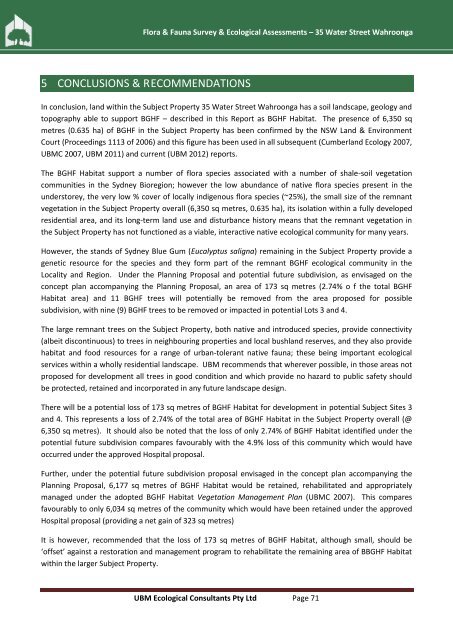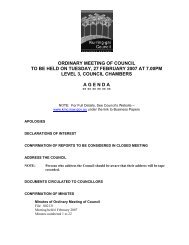Flora & Fauna Survey & Ecological Assessment (pdf. 5MB)
Flora & Fauna Survey & Ecological Assessment (pdf. 5MB)
Flora & Fauna Survey & Ecological Assessment (pdf. 5MB)
You also want an ePaper? Increase the reach of your titles
YUMPU automatically turns print PDFs into web optimized ePapers that Google loves.
<strong>Flora</strong> & <strong>Fauna</strong> <strong>Survey</strong> & <strong>Ecological</strong> <strong>Assessment</strong>s – 35 Water Street Wahroonga<br />
5 CONCLUSIONS & R ECOMMENDATIONS<br />
In conclusion, land within the Subject Property 35 Water Street Wahroonga has a soil landscape, geology and<br />
topography able to support BGHF – described in this Report as BGHF Habitat. The presence of 6,350 sq<br />
metres (0.635 ha) of BGHF in the Subject Property has been confirmed by the NSW Land & Environment<br />
Court (Proceedings 1113 of 2006) and this figure has been used in all subsequent (Cumberland Ecology 2007,<br />
UBMC 2007, UBM 2011) and current (UBM 2012) reports.<br />
The BGHF Habitat support a number of flora species associated with a number of shale-soil vegetation<br />
communities in the Sydney Bioregion; however the low abundance of native flora species present in the<br />
understorey, the very low % cover of locally indigenous flora species (~25%), the small size of the remnant<br />
vegetation in the Subject Property overall (6,350 sq metres, 0.635 ha), its isolation within a fully developed<br />
residential area, and its long-term land use and disturbance history means that the remnant vegetation in<br />
the Subject Property has not functioned as a viable, interactive native ecological community for many years.<br />
However, the stands of Sydney Blue Gum (Eucalyptus saligna) remaining in the Subject Property provide a<br />
genetic resource for the species and they form part of the remnant BGHF ecological community in the<br />
Locality and Region. Under the Planning Proposal and potential future subdivision, as envisaged on the<br />
concept plan accompanying the Planning Proposal, an area of 173 sq metres (2.74% o f the total BGHF<br />
Habitat area) and 11 BGHF trees will potentially be removed from the area proposed for possible<br />
subdivision, with nine (9) BGHF trees to be removed or impacted in potential Lots 3 and 4.<br />
The large remnant trees on the Subject Property, both native and introduced species, provide connectivity<br />
(albeit discontinuous) to trees in neighbouring properties and local bushland reserves, and they also provide<br />
habitat and food resources for a range of urban-tolerant native fauna; these being important ecological<br />
services within a wholly residential landscape. UBM recommends that wherever possible, in those areas not<br />
proposed for development all trees in good condition and which provide no hazard to public safety should<br />
be protected, retained and incorporated in any future landscape design.<br />
There will be a potential loss of 173 sq metres of BGHF Habitat for development in potential Subject Sites 3<br />
and 4. This represents a loss of 2.74% of the total area of BGHF Habitat in the Subject Property overall (@<br />
6,350 sq metres). It should also be noted that the loss of only 2.74% of BGHF Habitat identified under the<br />
potential future subdivision compares favourably with the 4.9% loss of this community which would have<br />
occurred under the approved Hospital proposal.<br />
Further, under the potential future subdivision proposal envisaged in the concept plan accompanying the<br />
Planning Proposal, 6,177 sq metres of BGHF Habitat would be retained, rehabilitated and appropriately<br />
managed under the adopted BGHF Habitat Vegetation Management Plan (UBMC 2007). This compares<br />
favourably to only 6,034 sq metres of the community which would have been retained under the approved<br />
Hospital proposal (providing a net gain of 323 sq metres)<br />
It is however, recommended that the loss of 173 sq metres of BGHF Habitat, although small, should be<br />
‘offset’ against a restoration and management program to rehabilitate the remaining area of BBGHF Habitat<br />
within the larger Subject Property.<br />
UBM <strong>Ecological</strong> Consultants Pty Ltd Page 71

















